Chenhui Gou
Emerging Properties in Unified Multimodal Pretraining
May 20, 2025Abstract:Unifying multimodal understanding and generation has shown impressive capabilities in cutting-edge proprietary systems. In this work, we introduce BAGEL, an open0source foundational model that natively supports multimodal understanding and generation. BAGEL is a unified, decoder0only model pretrained on trillions of tokens curated from large0scale interleaved text, image, video, and web data. When scaled with such diverse multimodal interleaved data, BAGEL exhibits emerging capabilities in complex multimodal reasoning. As a result, it significantly outperforms open-source unified models in both multimodal generation and understanding across standard benchmarks, while exhibiting advanced multimodal reasoning abilities such as free-form image manipulation, future frame prediction, 3D manipulation, and world navigation. In the hope of facilitating further opportunities for multimodal research, we share the key findings, pretraining details, data creation protocal, and release our code and checkpoints to the community. The project page is at https://bagel-ai.org/
Seed1.5-VL Technical Report
May 11, 2025Abstract:We present Seed1.5-VL, a vision-language foundation model designed to advance general-purpose multimodal understanding and reasoning. Seed1.5-VL is composed with a 532M-parameter vision encoder and a Mixture-of-Experts (MoE) LLM of 20B active parameters. Despite its relatively compact architecture, it delivers strong performance across a wide spectrum of public VLM benchmarks and internal evaluation suites, achieving the state-of-the-art performance on 38 out of 60 public benchmarks. Moreover, in agent-centric tasks such as GUI control and gameplay, Seed1.5-VL outperforms leading multimodal systems, including OpenAI CUA and Claude 3.7. Beyond visual and video understanding, it also demonstrates strong reasoning abilities, making it particularly effective for multimodal reasoning challenges such as visual puzzles. We believe these capabilities will empower broader applications across diverse tasks. In this report, we mainly provide a comprehensive review of our experiences in building Seed1.5-VL across model design, data construction, and training at various stages, hoping that this report can inspire further research. Seed1.5-VL is now accessible at https://www.volcengine.com/ (Volcano Engine Model ID: doubao-1-5-thinking-vision-pro-250428)
Mobile-VideoGPT: Fast and Accurate Video Understanding Language Model
Mar 27, 2025Abstract:Video understanding models often struggle with high computational requirements, extensive parameter counts, and slow inference speed, making them inefficient for practical use. To tackle these challenges, we propose Mobile-VideoGPT, an efficient multimodal framework designed to operate with fewer than a billion parameters. Unlike traditional video large multimodal models (LMMs), Mobile-VideoGPT consists of lightweight dual visual encoders, efficient projectors, and a small language model (SLM), enabling real-time throughput. To further improve efficiency, we present an Attention-Based Frame Scoring mechanism to select the key-frames, along with an efficient token projector that prunes redundant visual tokens and preserves essential contextual cues. We evaluate our model across well-established six video understanding benchmarks (e.g., MVBench, EgoSchema, NextQA, and PercepTest). Our results show that Mobile-VideoGPT-0.5B can generate up to 46 tokens per second while outperforming existing state-of-the-art 0.5B-parameter models by 6 points on average with 40% fewer parameters and more than 2x higher throughput. Our code and models are publicly available at: https://github.com/Amshaker/Mobile-VideoGPT.
Point-Cache: Test-time Dynamic and Hierarchical Cache for Robust and Generalizable Point Cloud Analysis
Mar 15, 2025Abstract:This paper proposes a general solution to enable point cloud recognition models to handle distribution shifts at test time. Unlike prior methods, which rely heavily on training data-often inaccessible during online inference-and are limited to recognizing a fixed set of point cloud classes predefined during training, we explore a more practical and challenging scenario: adapting the model solely based on online test data to recognize both previously seen classes and novel, unseen classes at test time. To this end, we develop Point-Cache, a hierarchical cache model that captures essential clues of online test samples, particularly focusing on the global structure of point clouds and their local-part details. Point-Cache, which serves as a rich 3D knowledge base, is dynamically managed to prioritize the inclusion of high-quality samples. Designed as a plug-and-play module, our method can be flexibly integrated into large multimodal 3D models to support open-vocabulary point cloud recognition. Notably, our solution operates with efficiency comparable to zero-shot inference, as it is entirely training-free. Point-Cache demonstrates substantial gains across 8 challenging benchmarks and 4 representative large 3D models, highlighting its effectiveness. Code is available at https://github.com/auniquesun/Point-Cache.
Evaluating and Advancing Multimodal Large Language Models in Ability Lens
Nov 22, 2024Abstract:As multimodal large language models (MLLMs) advance rapidly, rigorous evaluation has become essential, providing further guidance for their development. In this work, we focus on a unified and robust evaluation of \textbf{vision perception} abilities, the foundational skill of MLLMs. We find that existing perception benchmarks, each focusing on different question types, domains, and evaluation metrics, introduce significant evaluation variance, complicating comprehensive assessments of perception abilities when relying on any single benchmark. To address this, we introduce \textbf{AbilityLens}, a unified benchmark designed to evaluate MLLMs across six key perception abilities, focusing on both accuracy and stability, with each ability encompassing diverse question types, domains, and metrics. With the assistance of AbilityLens, we: (1) identify the strengths and weaknesses of current models, highlighting stability patterns and revealing a notable performance gap between open-source and closed-source models; (2) introduce an online evaluation mode, which uncovers interesting ability conflict and early convergence phenomena during MLLM training; and (3) design a simple ability-specific model merging method that combines the best ability checkpoint from early training stages, effectively mitigating performance decline due to ability conflict. The benchmark and online leaderboard will be released soon.
EZIGen: Enhancing zero-shot subject-driven image generation with precise subject encoding and decoupled guidance
Sep 12, 2024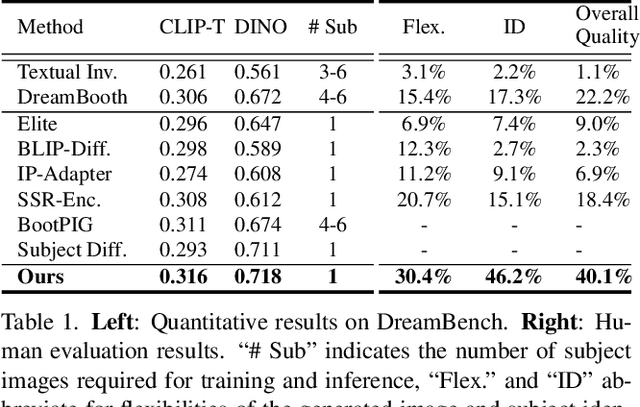
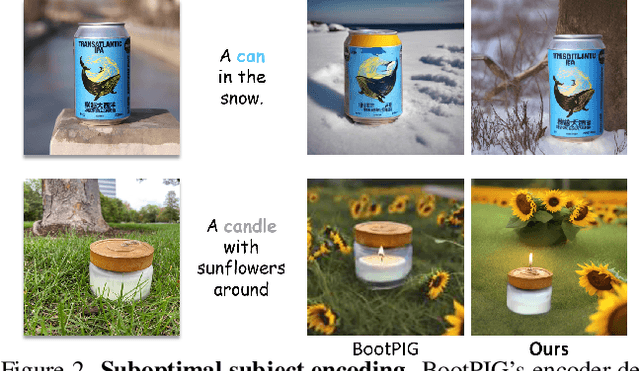
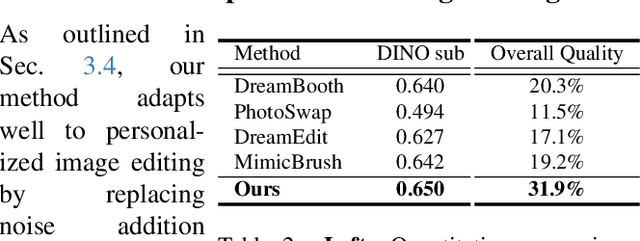
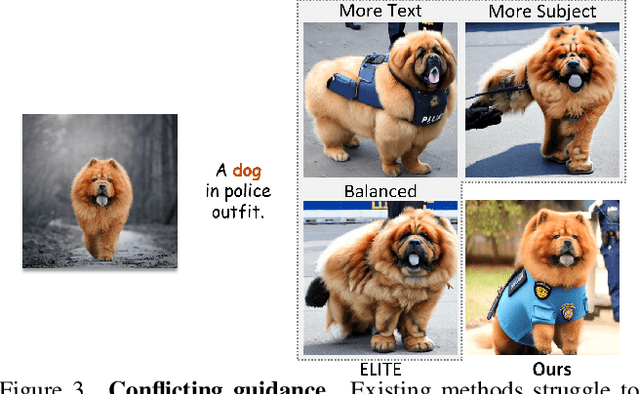
Abstract:Zero-shot subject-driven image generation aims to produce images that incorporate a subject from a given example image. The challenge lies in preserving the subject's identity while aligning with the text prompt, which often requires modifying certain aspects of the subject's appearance. Despite advancements in diffusion model based methods, existing approaches still struggle to balance identity preservation with text prompt alignment. In this study, we conducted an in-depth investigation into this issue and uncovered key insights for achieving effective identity preservation while maintaining a strong balance. Our key findings include: (1) the design of the subject image encoder significantly impacts identity preservation quality, and (2) generating an initial layout is crucial for both text alignment and identity preservation. Building on these insights, we introduce a new approach called EZIGen, which employs two main strategies: a carefully crafted subject image Encoder based on the UNet architecture of the pretrained Stable Diffusion model to ensure high-quality identity transfer, following a process that decouples the guidance stages and iteratively refines the initial image layout. Through these strategies, EZIGen achieves state-of-the-art results on multiple subject-driven benchmarks with a unified model and 100 times less training data.
How Well Can Vision Language Models See Image Details?
Aug 07, 2024Abstract:Large Language Model-based Vision-Language Models (LLM-based VLMs) have demonstrated impressive results in various vision-language understanding tasks. However, how well these VLMs can see image detail beyond the semantic level remains unclear. In our study, we introduce a pixel value prediction task (PVP) to explore "How Well Can Vision Language Models See Image Details?" and to assist VLMs in perceiving more details. Typically, these models comprise a frozen CLIP visual encoder, a large language model, and a connecting module. After fine-tuning VLMs on the PVP task, we find: 1) existing VLMs struggle to predict precise pixel values by only fine-tuning the connection module and LLM; and 2) prediction precision is significantly improved when the vision encoder is also adapted. Additionally, our research reveals that incorporating pixel value prediction as one of the VLM pre-training tasks and vision encoder adaptation markedly boosts VLM performance on downstream image-language understanding tasks requiring detailed image perception, such as referring image segmentation (with an average +10.19 cIoU improvement) and video game decision making (with average score improvements of +80.34 and +70.54 on two games, respectively).
InfiniBench: A Comprehensive Benchmark for Large Multimodal Models in Very Long Video Understanding
Jun 28, 2024Abstract:Understanding long videos, ranging from tens of minutes to several hours, presents unique challenges in video comprehension. Despite the increasing importance of long-form video content, existing benchmarks primarily focus on shorter clips. To address this gap, we introduce InfiniBench a comprehensive benchmark for very long video understanding which presents 1)The longest video duration, averaging 76.34 minutes; 2) The largest number of question-answer pairs, 108.2K; 3) Diversity in questions that examine nine different skills and include both multiple-choice questions and open-ended questions; 4) Humancentric, as the video sources come from movies and daily TV shows, with specific human-level question designs such as Movie Spoiler Questions that require critical thinking and comprehensive understanding. Using InfiniBench, we comprehensively evaluate existing Large MultiModality Models (LMMs) on each skill, including the commercial model Gemini 1.5 Flash and the open-source models. The evaluation shows significant challenges in our benchmark.Our results show that the best AI models such Gemini struggles to perform well with 42.72% average accuracy and 2.71 out of 5 average score. We hope this benchmark will stimulate the LMMs community towards long video and human-level understanding. Our benchmark can be accessed at https://vision-cair.github.io/InfiniBench/
DrVideo: Document Retrieval Based Long Video Understanding
Jun 18, 2024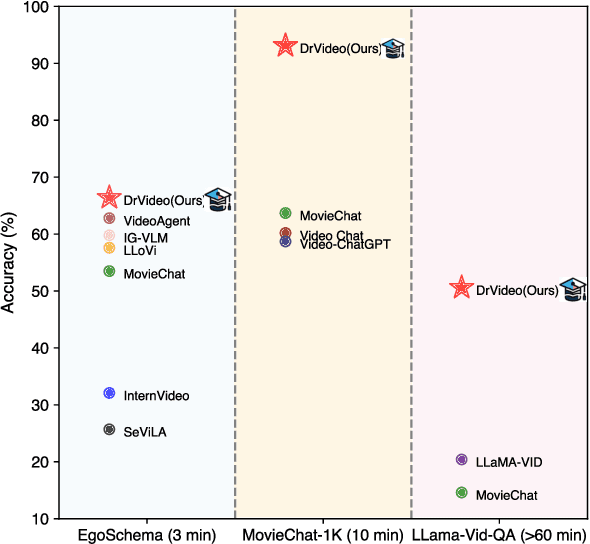
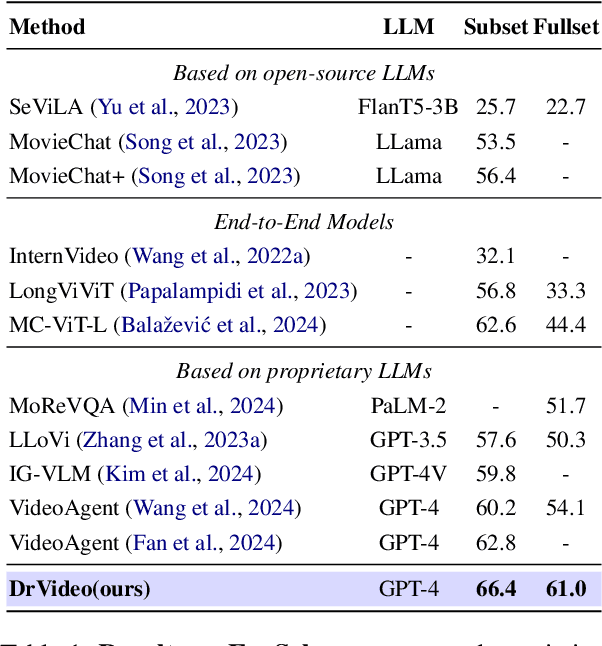
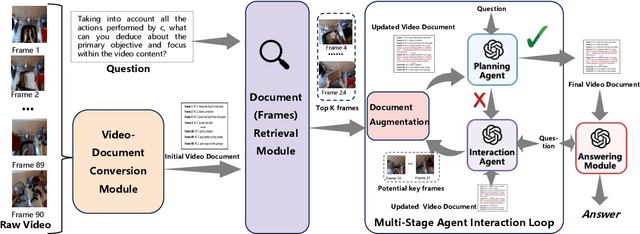
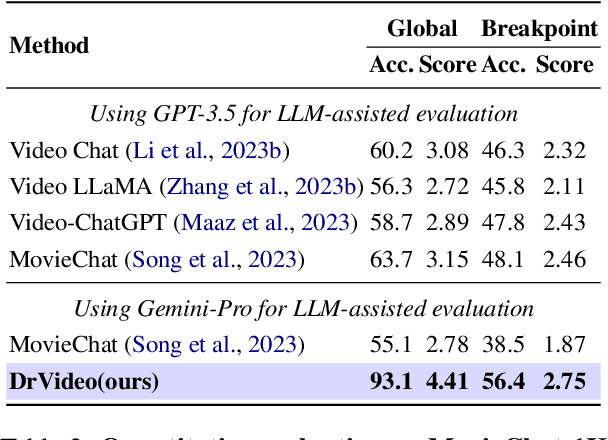
Abstract:Existing methods for long video understanding primarily focus on videos only lasting tens of seconds, with limited exploration of techniques for handling longer videos. The increased number of frames in longer videos presents two main challenges: difficulty in locating key information and performing long-range reasoning. Thus, we propose DrVideo, a document-retrieval-based system designed for long video understanding. Our key idea is to convert the long-video understanding problem into a long-document understanding task so as to effectively leverage the power of large language models. Specifically, DrVideo transforms a long video into a text-based long document to initially retrieve key frames and augment the information of these frames, which is used this as the system's starting point. It then employs an agent-based iterative loop to continuously search for missing information, augment relevant data, and provide final predictions in a chain-of-thought manner once sufficient question-related information is gathered. Extensive experiments on long video benchmarks confirm the effectiveness of our method. DrVideo outperforms existing state-of-the-art methods with +3.8 accuracy on EgoSchema benchmark (3 minutes), +17.9 in MovieChat-1K break mode, +38.0 in MovieChat-1K global mode (10 minutes), and +30.2 on the LLama-Vid QA dataset (over 60 minutes).
JRDB-PanoTrack: An Open-world Panoptic Segmentation and Tracking Robotic Dataset in Crowded Human Environments
Apr 02, 2024Abstract:Autonomous robot systems have attracted increasing research attention in recent years, where environment understanding is a crucial step for robot navigation, human-robot interaction, and decision. Real-world robot systems usually collect visual data from multiple sensors and are required to recognize numerous objects and their movements in complex human-crowded settings. Traditional benchmarks, with their reliance on single sensors and limited object classes and scenarios, fail to provide the comprehensive environmental understanding robots need for accurate navigation, interaction, and decision-making. As an extension of JRDB dataset, we unveil JRDB-PanoTrack, a novel open-world panoptic segmentation and tracking benchmark, towards more comprehensive environmental perception. JRDB-PanoTrack includes (1) various data involving indoor and outdoor crowded scenes, as well as comprehensive 2D and 3D synchronized data modalities; (2) high-quality 2D spatial panoptic segmentation and temporal tracking annotations, with additional 3D label projections for further spatial understanding; (3) diverse object classes for closed- and open-world recognition benchmarks, with OSPA-based metrics for evaluation. Extensive evaluation of leading methods shows significant challenges posed by our dataset.
 Add to Chrome
Add to Chrome Add to Firefox
Add to Firefox Add to Edge
Add to Edge